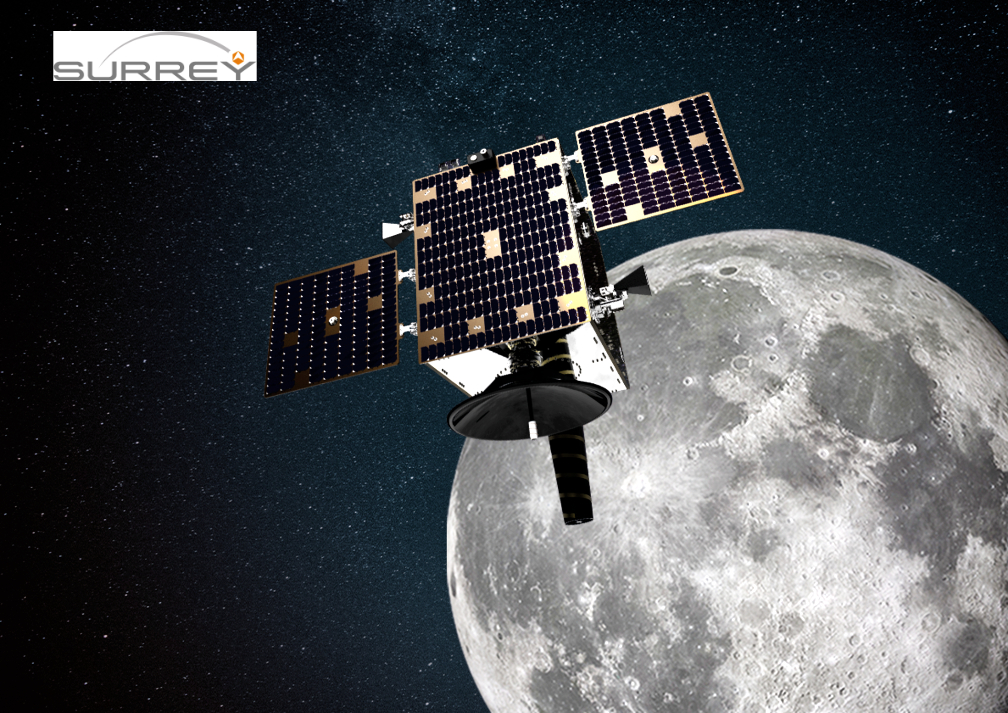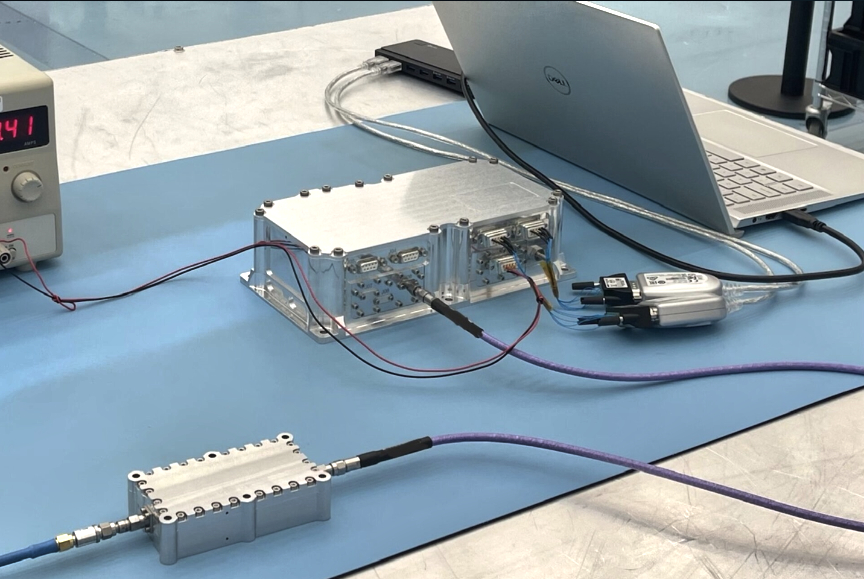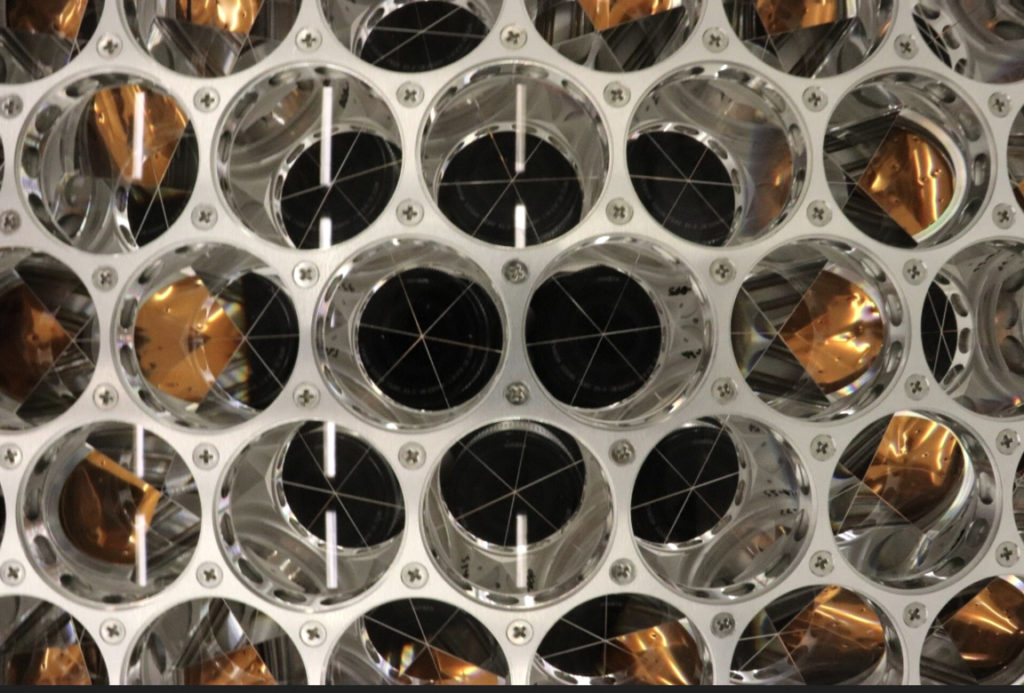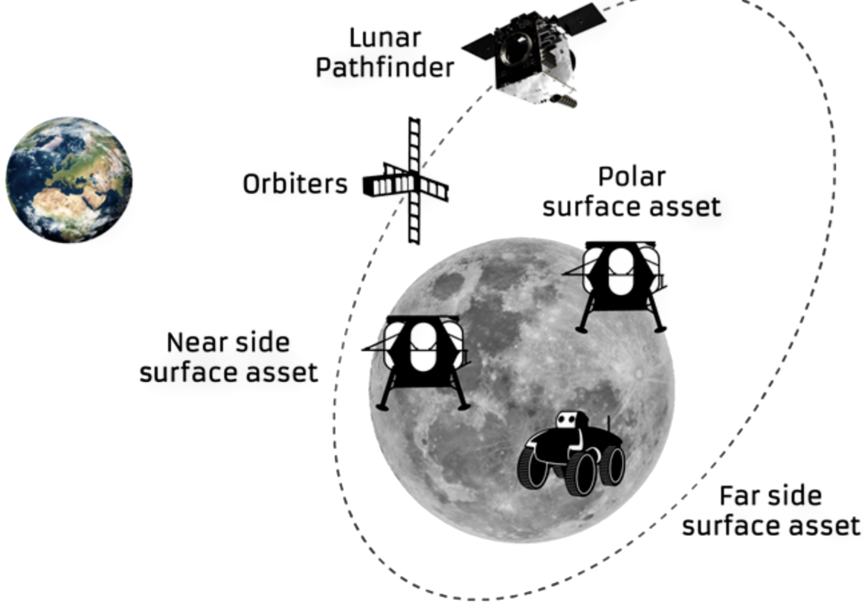
A NASA retroreflector array has been delivered to the European Space Agency (ESA) that will allow the Lunar Pathfinder mission to be pinpointed by laser ranging stations back on Earth as it orbits the Moon.

Such centimeter level laser measurements will serve as an independent check on the spacecraft as it fixes its position using Galileo and GPS signals from an unprecedented 400,000 km. away from Earth — proving the concept of lunar satellite navigation (SATNAV) while also relaying telecommunications ahead of ESA’s dedicated Moonlight initiative.

Safeguarded within multiple layers of packaging with ‘shock watches’ in three dimensions within the shipping case, to detect any rough treatment, NASA’s Laser Retroreflector Array, LRA, was successfully delivered to Surrey Satellite Technology Ltd. (SSTL), in Guildford, UK.
After unpacking and following the established procedures, a visual inspection of the LRA was jointly performed by ESA, NASA and SSTL, confirming there are no scratches and nicks in the optics. As a result, the instrument was formally accepted by ESA and was passed to SSTL for integration aboard their washing-machine-sized spacecraft, which is due to be launched in 2025.
SSTL’s Lunar Pathfinder will serve as a telecommunications relay satellite for future missions to the Moon, with ESA as a core customer, while NASA will also make use of its services in exchange of delivering Lunar Pathfinder to lunar orbit through its Commercial Lunar Payload Services (CLPS) initiative.

Today, tracking a spacecraft in lunar orbit requires multiple ground stations to perform radio ranging. Lunar Pathfinder will employ a standard X-band transponder for this purpose, but in addition will carry ESA’s NaviMoon Global Navigation Satellite System receiver (photo below).

Achieving position fixes from Galileo and GPS so far out in space requires clever engineering and signal processing techniques, because the signals extending out to lunar orbit are millions of times weaker than those we receive using our smartphones or cars. But success would mean future Moon missions could effectively steer themselves – fixing their position automatically using GNSS better than 100m, an order of magnitude improvement over current radio ranging – while foregoing the use of costly ground infrastructure.
Laser retroreflectors are well-established space technology, normally used to precisely determine the orbit of satellites around the Earth. By measuring the time of flight for the laser pulses to travel from Earth to the satellite and back, its precise distance can be calculated — along the same lines as radio-based ranging, but achieving much higher accuracy because of the short wavelength of light.
In approach they resemble the mirrored ‘cat’s eyes’ embedded in motorways to reflect light precisely back to its source, thanks to an intricate internal reflection setup — a total of 48 ‘corner cubes’ in the case of the LRA, which were individually and rigorously inspected and measured in the laboratory. The optical performance of the array was accurately measured at NASA’s Goddard Space Flight Center.
About the size of a laptop, the LRA was produced for NASA by KBR, based on a previous LRA already flying on NASA’s Lunar Reconnaissance Orbiter (LRO). The International Laser Ranging Service currently has four stations capable of laser ranging out to lunar distance, three based in Europe (Grasse, Wetzel, and Matera) and one in the US (Apache Point). In addition, ESA is considering the use of its own Tenerife-based Laser Ranging Station, which is currently being upgraded.

As a next step, the LRA will undergo final inspection at SSTL before being integrated onto Lunar Pathfinder — having to be precisely fitted and aligned to maximize positioning accuracy. Then, in the decade to come, dedicated Moonlight satellites and eventually additional hardware on the lunar surface will establish a common communications and navigation infrastructure for all lunar missions, effectively bringing the Moon closer to Earth in practical terms, rendering it our planet’s eighth continent.
Moonlight is being presented to Europe’s space ministers for approval at ESA’s Council at Ministerial Level in Paris on 22-23 November.
“Today’s delivery is an additional element of this unique ESA-NASA collaboration, which includes an in-orbit test campaign to demonstrate the use of satellite navigation signals in lunar orbit and laser ranging to authenticate these pioneering satnav positioning fixes,” said Javier Ventura-Traveset, leading ESA’s Galileo Navigation Science Office and coordinating ESA lunar navigation activities. “Both ESA and NASA are highly interested in exploiting the LRA data with our NaviMoon satnav receiver, which will enable the cross-checking of positioning fixes across cislunar distance and open up new possibilities in lunar geodesy. These tests will also provide a very valuable technological learning for ESA’s Moonlight initiative, which will provide before the end of this decade an autonomous network of communications and navigation satellites supporting lunar exploration.”
Stephen Merkowitz, NASA’s Space Geodesy Project Manager, said, “This LRA is larger and will return more than 12 times the laser light than the one on LRO since it has 48 corner cubes at 4 cm in diameter, compared to LRO’s 12 reflector cubes at 3 cm in diameter. This opportunity is then rather unique.”
Lily Forward, SSTL Lunar Pathfinder Systems Engineer, said, “This is SSTL’s first piece of flight hardware for the Lunar Pathfinder and is the result of an excellent collaboration between ESA, NASA and SSTL. We are all eager to put this ranging experiment to the test once SSTL’s Lunar Pathfinder has launched.”

About the Lunar Pathfinder
SSTL’s Lunar Pathfinder is a single spacecraft in lunar orbit that is due to launch in 2025, designed with the objective of offering communication services to a number of lunar assets (surface or orbiter), as well as hosting a number of navigation and scientific experiments.
Communication Services
Lunar Pathfinder is due to operate in an Elliptical Lunar Frozen Orbit (ELFO) for an operational lifetime of 8 years. The spacecraft can operate 2 simultaneous channels of communication with lunar assets: 1 in S-band and 1 in UHF. Performance, such as coverage and data-rate, depend both on the relative position of the user asset to Pathfinder at the moment of the connection, as well as the capabilities of the communication module onboard the user asset. Once safely retrieved onboard Lunar Pathfinder, communications are relayed back to Earth ground stations in X-band.

For surface assets on the far side of the Moon, the use of data-relay infrastructure is a requirement for their missions. Without of line of sight of the Earth, they need a data-relay service such as the one offered by Lunar Pathfinder to communicate back with Earth.
For polar surface assets, potentially with limited direct to Earth visibility, the use of the data-relay service provides the assurance of a communication link, whatever obstacle the terrain may put between the asset and the Earth.
Rovers, constrained to remain within line of sight of the lander to relay their communication, will find a new independence, both in how far they can go from the lander and how long they can survive beyond the lander’s limited lifetime.
For all lunar missions, including orbiters and near side surface assets, which could manage with Direct to Earth (DTE) communication , there is an additional economical and technical benefit to using the proximity data-relay service. Due to the proximity of the Lunar Pathfinder spacecraft, user assets could achieve higher data-rates with a lower performance, lower mass and lower cost communication module on-board, compared with the equipment needed for DTE communication.
In addition to communication services, the Lunar Pathfinder spacecraft has been selected by ESA and NASA to host a number of experimental payloads:
- An ESA GNSS receiver capable of detecting weak signals coming from the Earth GNSS infrastructure (GPS and Galileo), demonstrating its potential role into Lunar navigation
- A NASA retro-reflector to demonstrate laser ranging capabilities
- An ESA radiation monitor to study orbital radiation conditions
Acting both as technology and service demonstrator, Lunar Pathfinder is the opportunity for scientific and commercial mission developers to support the development, test and standardization of Lunar communication infrastructure, and for emerging off-planet telcos to acquire experience of lunar asset operations and off-planet service delivery.
A Lunar Pathfinder infovideo is located at this direct link…
